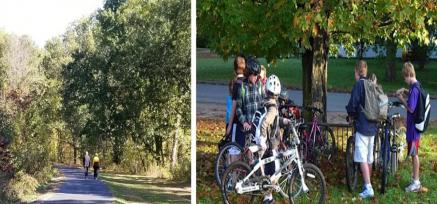Benefits of Walking and Biking for Simsbury
Economic
Research by Headwaters Economics shows that homes near walkable and bikeable trails enjoy premiums of between 5% to 10%. Other surveys have put that percentage even higher. In addition, those who walk and bicycle on greenways often stop to eat, drink, and recreate in their destinations.
Sense of community
Pedestrians move at a pace that allows for face-to-face interactions. In many ways Simsbury's trail system has become a "town green" where residents can meet and share a sense of community. Bicyclists also share a sense of community and are more likely to stop at trail side venues, to rest, eat and shop.
Better access
Walking and bicycling provide an alternative option to driving. For those who do not have the option to drive, such as people with certain disabilities, this lack of choice in transportation creates an inconvenient and unjust barrier to mobility. We want our community to be inclusive and accessible to everyone.
Health
The U.S. Department of Health and Human Services recommends 10,000 steps per day to achieve better health and fitness. Bicycling is a low-impact exercise that improves overall balance and coordination. Both activities increase the health of the heart and cardiovascular systems and can improve resistance to obesity related health problems such as strokes, diabetes, and cancer. More trails and a walkable environment promote an active lifestyle and health choices in the community.
Environment
Pedestrians and bicyclists require less space on the roadway than drivers. According to the EPA, vehicular transportation is responsible for nearly 80 percent of carbon monoxide and 55 percent of nitrogen oxide emissions in the U.S. Communing or running errands by walking and biking promotes a cleaner environment.


